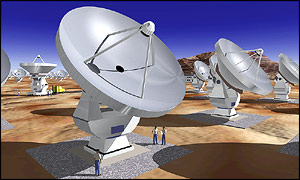
With Alma we have the best chance of seeing the earliest galaxies
Catherine Cesarsky
After completion of Alma's design phase, construction could be approved at the European Southern Observatory organisation's council meeting in London this week.
Alma will consist of 64 giant microwave receivers - each 12 metres across - to be built at Chajnantor, 5,000 metres up in one of the most inhospitable part's of the Atacama Desert of northern Chile.
The aim is to detect radiation at millimetre and sub-millimetre wavelengths, studying galaxies and planets that form in cold, dusty regions that cannot easily be studied in other wavebands.
UK joins astronomy super-club
New collaborators
If construction gets underway next year, Alma would become part-operational in 2008, with completion in 2011.
Alma facts
Will be largest ground-based astronomy project ever
Will be located at an altitude of 5,000 metres in the Atacama desert
Will be a network of 64 12-metre radio telescopes
Building work to start in 2003 with completion in 2011
The project is a collaboration between Europe and the US, after the merger of two major millimetre astronomy projects - the European Large Southern Array and the US Millimeter Array.
Europe and the US - through the National Science Foundation - will be equal partners in the project, thanks mainly to Eso's increased budget following the new membership of the UK.
Japan has also expressed interest in joining the project and Spain, a non-Eso member is currently negotiating terms for collaboration.
Solar system beginnings
Catherine Cesarsky, Director General of Eso, told BBC News Online: "At the moment, we have very few opportunities to do observations in the sub-millimetre range.
"There is a European satellite called Herschel in preparation, which will do some things that Alma cannot do. But we will be much more sensitive and because of the 64 antennae, which can be separated by up to 10 kilometres, Alma will be able to detect sources that are very faint and will be able to map things very accurately.
How astronomers survive in the Atacama Desert
"We expect to be able to study planets around stars and to study the chemistry of regions in which stars form. That will help us to understand the genesis of our own Solar System.
"We think galaxies form in regions with a lot of dust and emit a lot of their energy at these wavelengths, especially if they are far away. Our calculations tell us that with Alma we have the best chance of seeing the earliest galaxies."

